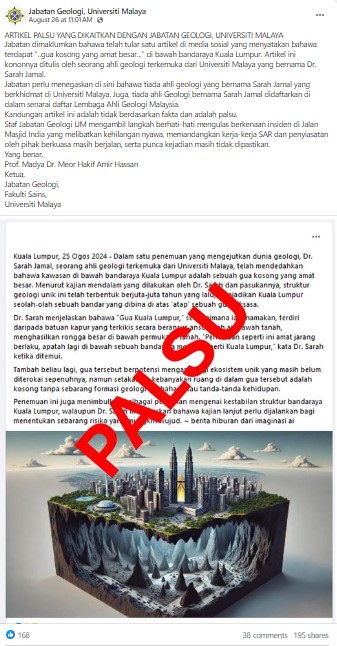Geologists have dismissed social media posts falsely claiming that Malaysia’s capital Kuala Lumpur was built on a “big, empty cave”, saying the idea was impossible. The misinformation spread across Facebook, TikTok and Instagram after an Indian tourist fell into a sinkhole in the city in August 2024, but the claim circulated in a TikTok post tagged “entertainment news made with AI”.
“Kuala Lumpur, August 25, 2024 – In a shocking discovery, a leading geologist from the University of Malaysia (UM) has revealed that an empty giant cave formed beneath Kuala Lumpur millions of years ago,” a Malay-language Facebook post from August 26th.
“An in-depth study by Dr. Sarah Jamal and her team from UM claimed that the geological structure was formed millions of years ago, making the city appear as if it were built on the ‘roof’ of a giant cave.”
The report claimed that the cave system was formed by erosion of limestone by groundwater and raised concerns about the stability of the Malaysian capital.
The accompanying image shows Kuala Lumpur’s iconic skyscrapers: the Petronas Twin Towers and the KL Tower. The city appears to be situated on a large cave.
The claim came to light days after an Indian tourist disappeared when she was swallowed by an eight-metre deep subsidence in Jalan Masjid India in Kuala Lumpur – a popular tourist destination – on August 23 (archived link).
Five days later, a second sinkhole appeared on the same street, forcing authorities to close the road and integrity audit of the sewer system in the area (archived link).
The search query for the missing woman was called off after a nine-day rescue operation due to safety concerns (archived link).
The same claim also came up on Facebook, Instagram And TikTok.
However, the “news” about a large cave system beneath the Malaysian capital was also shared on TikTokwhere it was labeled as “AI-generated news for entertainment”.
Google keyword searches followed by a reverse image search yielded a Facebook post of the Geology Department of the Universiti Malaya, who said that there was no “Dr. Sarah Jamal” employed and that no such person was registered with the Board of Geologists Malaysia (archived here And here).
“The content of the message is not based on facts and is incorrect,” the Malaysian message dated August 26 said.
‘Impossible’
“It is virtually impossible that Kuala Lumpur can stand on a hollow foundation when such a large cave system exists,” he said. Nor Shahidah Mohd Nazer a geologist at the Department of Earth Sciences and Environment, Universiti Kebangsaan Malaysia on September 18 (archived link).
She urged the public to remain calm, saying that sinkholes not caused by limestone are usually localised and small in size.
In the meantime, Gosh Thian Lai from the Department of Earth Sciences and Environment at Universiti Kebangsaan Malaysia said the sinkhole in Jalan Masjid India was caused by human activities, and not by natural forces (archived link).
The sinkhole was likely caused by a burst sewer pipe, which allowed fill material under the walkway to be carried away by the flowing water into the sewer pipes, he told AFP on September 23.
“This phenomenon created a hollow space under the walkway,” he said.
On September 7th propositionMalaysia’s Ministry of Natural Resources and Environmental Sustainability has also denied claims that Kuala Lumpur is unstable (archived link).
Geologically, the ground beneath the city was 30 percent limestone and 70 percent granite. The area where the sinkhole formed was composed of shale, quartzite and phyllite rocks, the statement said.
“We urge the public not to engage in speculation by unscrupulous parties about the safety of Kuala Lumpur and to seek their information from the appropriate authorities,” the report said.







